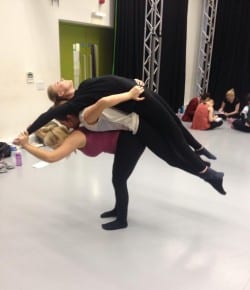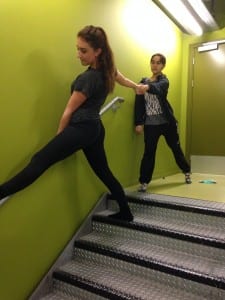Previous to our first research lab, I read the two articles by Daniel Pkoff in order to understand release technique and the questioning of improvisation. Daniel looks at Mary Fulkerson’s anatomical release technique. The technique focuses on eliminating habitual patterns in the body, as well as the mind, in order to create more unique contact improvisation’s. ‘by the time an intention has become realised in a physical action, it is too late to alter how the action is played out’ (Pkoff, D, 1999). This quote I found useful in understanding that taking risks is the exciting part of contact improvisation. Eliminating mindfulness in improvisation. allows you to become more involved within it. The article expresses the view that you shouldn’t rely on habits or reflexes to take over during improvisation. However, be prepared for the surprises in which improvisation obtains. Questions which dancers come across during improvisation are
where is my centre?
What surfaces are touching/ being touched?
Which of these surfaces offer support?
Throughout the research lab I took these questions into consideration, in order for them to effect my research. I wanted to find out whether applying questions within my improvising would allow me to create a better overall experience throughout the workshop.
‘Does the environment effect how me move during contact improvisation’
We related our question and practice from Daniel Lepkoff’s contact improvisation study : “The body’s innate ability to respond physically to it’s environment”.Lepkoff, D. (2008) . We wanted to see how the body would respond to environmental factors, whether it would benefit our improvisation process or make it more difficult to perform.Initially our focus was to benefit from exploring new questions which would expand our improvisation abilities and would allow us to move away from habitual movement. However, throughout the exploration of our question, new questions were developed along the way.
We went on to answer our question during the three hour workshop. We looked at several tasks which focused on changing environmental factors such as location, sound and surroundings. We began with experimenting with improvisation in a condensed corridor whilst performing s duet. We found this space rather difficult to move in as it was so condensed and people would walk past causing distraction. However, it made us question Does a small space allow us to experiment more with contact rather than individually?
Moving on from this we decided to perform movement in a less stable un level environment. We challenged improvisation by using stairs to perform on. Throughout the experience I felt fully conscious about giving my weight, and unable to relax especially with my eyes closed. It wasn’t that I was un trusting of my partner but I was fearful of moving in an un habitual way causing me to be become unstable.
Rolling became specifically difficult. However, I felt I did benefit from this exercise growing trust with a partner I haven’t specifically worked with before. The other two girls in my group went on to perform outdoors in the public eye. At first they felt apprehensive of the people looking, but as they closed their eyes they become less aware of their surroundings and began to feel comfortable. Me and Harriet also experimented with using contact improvisation on blocks outdoors. We found that different surfaces allowed us to experiment with movement and also giving and receiving weight.
During this experiment we decided to try different outdoor surfaces such as the grass. Our first instinct was that the grass would be a safe and soft surface for tactile rolling and sliding. We agreed that this surface would give us greater ability to experiment with weight as no surrounding or people would become a distraction. When we first started working on the grass we realised the grass was cold and wet so at first we felt reluctant to take our contact to the floor. Further into the duet, we experimented with rolling and sliding. But surprisingly we found it rather difficult to roll on the grass as the surface caused a lot of friction. This led us to the question ‘which surface would enable easier rolling and sliding?’ Within this task we were asked to experiment with our eyes closed. Watching Naomi and Harriet within this task, I felt Naomi often held Harriet’s hands for contact, and I discovers that this was a safety barrier for hew. The two girls haven’t danced with each other before, so she felt Harriet’s safety was crucial in order for the improv to be successful. However, when I were to dance with Harriet I felt more of a connection due to having danced with her before I felt safe to give her my full weight and I was knowledgeable that we were supported by the grass beneath us.
Moving inside for our final task we experimented in the workshop space surrounded by people developing their research labs. Performing in this space became much of a distraction to our improvisation. I felt drawn in to the conversations around me rather than relax causing me to lose concentration on my movements with my partner. A question which I would take from this is
‘How can I cancel out any surrounding distractions?’.
Jam
During this weeks Jam I wanted to explore with movement and further my feelings towards my surroundings whilst trying to work with new people. To start the jam we relaxed our bodies giving weight to the floor and to our partner. During this exercise I felt very relaxed, which allowed me to feel comfortable at ease and stress free throughout the jam. This week felt specifically different to the others. The whole group felt comfortable among each other giving and taking more weight than usual. I found myself working with people I wouldn’t usually work with which really opened my mind to what I can do and achieve in the future. The whole group felt more trusting and I believe this could be due to the trusting tasks some other members of the group studied for their research lab. I found myself answering my own question from the workshop ‘How does environmental factors effect movement quality’. I felt the atmosphere with the lights off and everyone merging together to create a successful piece allowed me to feel at ease and totally relaxed.

![IMG_6632[1]](https://ellieosullivancontactimprov.blogs.lincoln.ac.uk/files/2014/10/IMG_66321-e1414694245145-225x300.jpg)

![IMG_6620[1]](https://ellieosullivancontactimprov.blogs.lincoln.ac.uk/files/2014/10/IMG_66201-e1414695246274-225x300.jpg)
![IMG_6607[1]](https://ellieosullivancontactimprov.blogs.lincoln.ac.uk/files/2014/10/IMG_66071-e1414695204358-225x300.jpg)
![IMG_6573[1]](https://ellieosullivancontactimprov.blogs.lincoln.ac.uk/files/2014/10/IMG_65731-300x225.jpg)